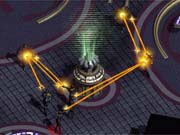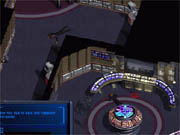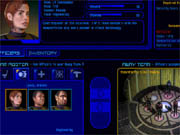With the proliferation of all sorts of games based on the Star Trek universe, a real-time strategy game with individual crewmembers as characters is probably the only type of Star Trek game that had yet to be made. Since it features man-to-man tactics, a variety of weapons and futuristic equipment, an original story, and some role-playing elements, the possibilities for a game like Star Trek Away Team are quite promising. Unfortunately, the final design didn't follow through on any of these possibilities. Instead, Star Trek Away Team is a linear, repetitive, tedious game that ignores almost every lesson it should have learned from previous, more successful tactical combat games like X-COM, Jagged Alliance, and Commandos.

The basic idea of Star Trek Away Team is very similar to that of Commandos: You control four or six characters in real-time combat scenarios and lead them through a series of missions that require stealth and tactical skill to defeat a numerically superior enemy. Before each mission, you choose your team members from the command, medical, engineering, science, and security fields. Each briefing lists the required and suggested items for that mission, and clicking on a crewmember will indicate which of those items he or she has in inventory. This is a nice feature until you realize that just like in Commandos, you can't redistribute inventory items--they are permanently associated with crewmembers. In addition, characters don't gain experience, and their health is fully restored between missions, so you never really grow attached to anyone. The crewmembers are essentially interchangeable--you're more likely to remember someone for a particular item he or she carries than for the character itself. This kills any sense of involvement in the story.
That's a shame, because the environments and the voice acting are both of very high quality. The unit acknowledgements are rather repetitive, but the voice-overs (both in the briefings and in the game itself) are well done, including those done by the voice of Commander Data. The graphics are 2D, but different levels allow a lot of variation in scenery, both in outdoor and indoor environments, and the result is good. Unfortunately, the game art is optimized for one resolution only (640x480), which causes the zoom functions to pixelate the screen horribly. There are also some problems with some of the animations, as phaser shots can sometimes stop in midair, especially if the target moves. Despite this, the graphics and sound are the best part of the game.

The gameplay is tightly scripted. It's so scripted, in fact, that certain triggers for voice-overs remain active even after they've become superfluous. For example, at one point on the Borg demolition mission, Matrina Sedik will make a comment that's supposed to be a hint as to how to deactivate the Borg security walls, even if you've just gone through the entire level doing exactly that. Apparently, the game expected you to turn right at the beginning, and if you turn left, that trigger simply waits until you come back and hit it. It's followed by an even more incongruous narrative comment that reinforces the feeling that the missions were designed more as plot elements in the larger story than as tactical exercises.
There are some very good ideas in the game that end up being unutilized because of the poor level design. The fact that your characters will make more noise while running than walking is elegantly portrayed by "sound cones," which show the distance that this noise travels; they can easily be toggled on and off. Firing weapons makes noise, which can alert guards that something is wrong and can make them change their patrol patterns. Had this been used as the basis for a less puzzlelike level design, it could have been very interesting.
Unfortunately, none of this matters at all. The first third of the game (there are 18 missions in all) can be completed by simply selecting all of your characters, setting them to "run," and following the tortuously twisting corridors and walkways on the minimap directly to each objective while pausing only long enough to shoot en masse at each enemy. Since there is no fog of war, it's easy to wait until an enemy is directly behind a door before opening it and blasting him into oblivion, although even these halfhearted attempts at finesse are generally unnecessary. It's a sign of how badly the level designers failed when you find yourself passing up all the extra weapons and healing devices that are scattered about a level, simply because they're too much trouble to stop for. Completing a level is a dispiriting journey from point to point, as it simply involves killing or stunning (as per your orders) a couple of enemies every now and then. Eventually you find your objective, use the designated item to deactivate the final security door, and it's on to the next mission. Occasionally you'll be given an additional objective in midmission, but this simply means adding one more waypoint to the innumerable ones you have already. In the end, it makes no difference. Only in later missions does it become necessary to give any thought to completing a mission, and this simply becomes a puzzle-solving exercise (albeit not a difficult one) in which you have to mechanically account for each individual enemy you'll encounter as though following a script. Since you can give orders while the game is paused, you simply walk up to an enemy, kill him, pause the game, find the next enemy, target him, and repeat this process over and over.

This problem is made worse by the absolute lack of any artificial intelligence for friendly units, which is another characteristic Away Team shares with Commandos. If one of your units is being shot from behind at point-blank range, it will not turn around. If it can see its assailant, it will not lift a phaser unless you specifically tell it to. It's a giant step back from the real-time combat in X-COM: Apocalypse, which handled these issues much better.
The attempts at simulating guard awareness also fall flat. Guards can be alerted by the sight of bodies or the sound of weapons, which would be a good idea if it didn't usually make them come running straight into your poised phasers. It's possible for guards to sound a general alarm, but only if one of your mission objectives is to not have them sound a general alarm, in which case one missed phaser shot is usually enough to cost you the mission. Otherwise, guards are activated (by hearing noises, seeing a dead body, and so forth) on an individual basis, and killing or stunning half of the enemy security team isn't enough to make the other half wise up.

To add to the frustration, there is a host of annoying bugs that often get in the way. A character's inventory generally defaults to selecting a phaser as the current item, which is convenient if you forget to reassign your engineering officer's weapon after using a security hack. Unfortunately, this tends to make everything default to a standard phaser, meaning that your security officer's Phaser 3 or sniper rifle will also revert to the standard phaser, often at the worst times. Sometimes if you select to have your whole team fire at a target, but one unit within the group has an obstructed line of sight, your entire group may be prevented from firing. At other times you can fire, and those within the group without a line of sight to the target will end up shooting into a wall or other obstacle. Since the level architecture can't be destroyed, this is useless.
Had Star Trek Away Team incorporated real character building, included better enemy AI (as well as any AI whatsoever for your own units), allowed for more freedom in both equipment use and discovery, and required actual small-unit tactics instead of mindless sprinting and head-on encounters or tedious puzzle-solving, it could have been a good strategy game. As it stands, it's not much more than an episode of The Next Generation that requires a lot of mouse clicking.